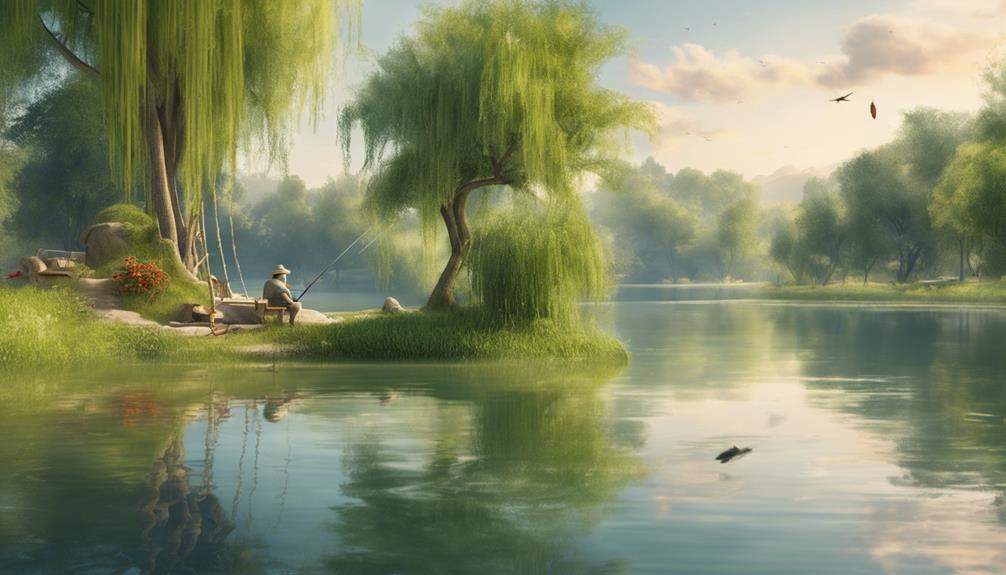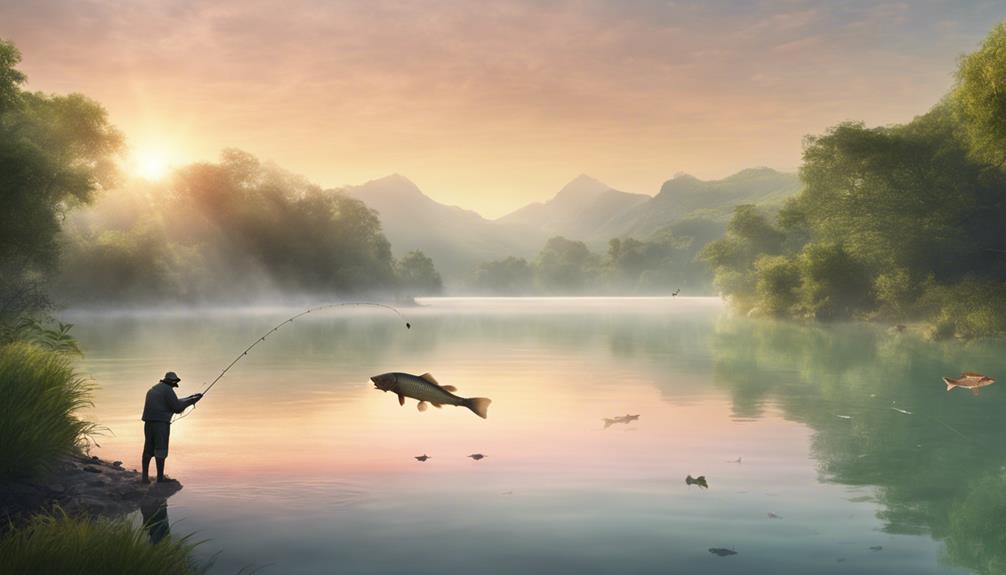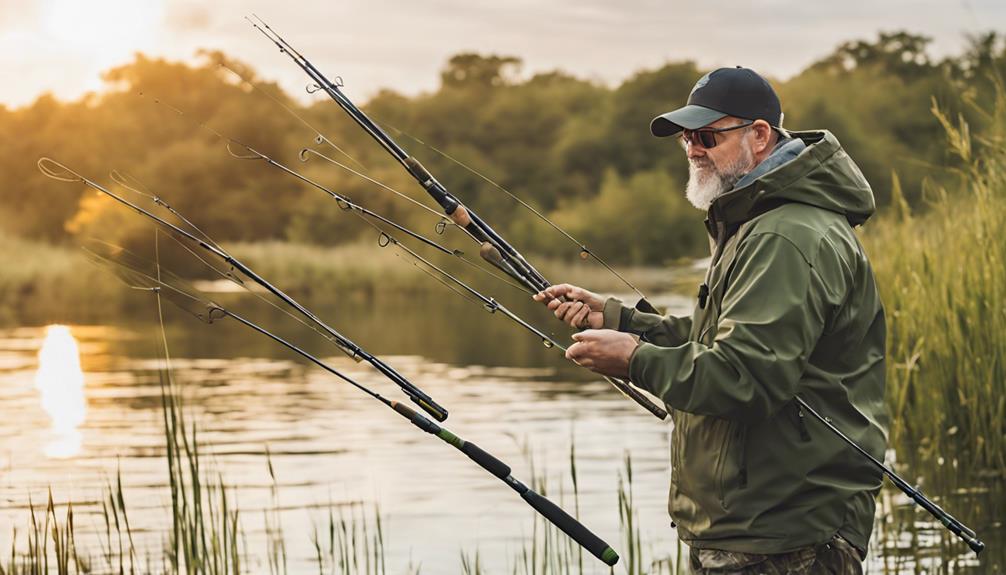To optimize carp fishing success, target different seasons strategically. During spring, focus on shallow waters and use precise gear for casting. Summer calls for vegetation-rich areas and flavorful baits. In fall, aim for shallower spots with varied baits as carp intensify feeding. In winter, patience with lighter gear in stable waters is key. Understand pre-spawn behaviors for successful spring fishing. Carp change habits during spawn, requiring subtle baits near shelters. Post-spawn, adapt tactics based on rising temperatures. Knowing water temperature influences and moon phases can also enhance fishing outcomes. Tailoring techniques to seasonal carp behaviors will boost your catch rates.
Spring Carp Fishing
To maximize your success during the spring carp fishing season, prioritize scouting for feeding grounds near shallow waters. This period presents a prime opportunity to hone in on tackle selection and bait presentation techniques to entice carp effectively.
When it comes to tackle selection, opt for gear that allows you to cast with precision and control. Choose a sturdy rod with a sensitive tip to detect subtle bites, paired with a reliable reel that offers smooth drag to handle the potentially large carp you may encounter. Monofilament or braided lines in the 8-12lb range are ideal for spring fishing, providing the right balance of strength and sensitivity.
In terms of bait presentation, consider using a method that keeps your bait close to the bottom where carp often feed during the spring. Boilies, corn, or soft pellets are popular choices during this season. Utilize hair rigs to present your bait effectively, ensuring that the hook is exposed for better hooking potential. Employing a baiting strategy that involves pre-baiting the area can also increase your chances of attracting carp to your fishing spot.
Summer Carp Fishing
During the summer carp fishing season, focus on locating areas with abundant underwater vegetation to increase your chances of catching carp. Carp tend to seek refuge and feed in these areas during the warmer months, making them prime locations for successful fishing.
- Water Temperature: In the summer, water temperatures rise, impacting carp behavior. Warmer waters increase carp metabolism, leading them to be more active and requiring more food. Focus on fishing during the cooler parts of the day when the water temperature is slightly lower, as carp may be more active during these times.
- Bait Selection: With the increased metabolism in the summer, carp are actively feeding. Opt for baits that have strong scents and flavors to attract carp in the warmer waters. Sweetcorn, boilies, and pellets are popular bait choices during the summer months. Experiment with different baits to see what works best in the specific waters you're fishing.
- Underwater Vegetation: Carp love to forage among underwater vegetation during the summer. Look for areas with plenty of vegetation such as lilies, hydrilla, or coontail. These areas not only provide food sources for carp but also offer them shelter and security. Casting your bait near these areas can increase your chances of a successful catch during the summer carp fishing season.
Fall Carp Fishing
In the fall, carp fishing conditions transition as water temperatures cool, influencing carp behavior and feeding patterns. As water cools down, carp become more active in search of food to store energy for the upcoming winter months. This shift in behavior presents a prime opportunity for anglers to capitalize on fall carp fishing.
When targeting carp in the fall, using the best bait is crucial. Carp are known to be less selective during this season, making it easier to attract them with a variety of baits. Popular options include maize, boilies, and bread crusts. These baits are effective in enticing carp due to their visual appeal and scent, which can lure carp even in cooler water temperatures.
In terms of the ideal location for fall carp fishing, look for areas where carp are likely to feed actively. Shallow areas near the shore, especially those with aquatic vegetation or fallen trees, can be productive spots. Carp tend to gather in these areas to feed on natural food sources like insects and algae. Additionally, areas with a slow current or eddies can also attract carp as they provide a comfortable feeding environment.
Winter Carp Fishing
How can winter temperatures affect the behavior of carp, impacting their feeding habits and movement patterns in bodies of water? Winter brings about significant changes in the behavior of carp due to the drop in water temperatures. Understanding these changes is crucial for successful winter carp fishing.
Here are three key points to consider for winter carp fishing:
- Decreased Metabolism: In cold water, carp's metabolism slows down, reducing their overall activity levels. This means they require less food to sustain themselves during the winter months. As a result, carp may feed less frequently and be more selective about the baits they consume.
- Deep Water Locations: Carp tend to seek out deeper waters in winter as they offer more stable temperatures. Look for areas with depth, where the water is slightly warmer than the shallower regions. Carp may also gather in large groups in these deeper spots.
- Patience and Precision: Winter carp fishing requires patience and precision. When targeting carp in colder conditions, it's essential to present baits subtly and accurately. Lighter rigs and smaller baits are often more effective during this time. Additionally, maintaining a stealthy approach is crucial to avoid spooking the cautious winter carp.
Pre-Spawn Carp Fishing
Winter temperatures significantly influence carp behavior, transitioning to pre-spawn conditions triggers notable changes in their movements and feeding preferences. Pre-spawn carp fishing is a crucial period where the fish start to prepare for spawning, exhibiting increased activity levels and voracious feeding habits. Understanding pre-spawn behavior is essential for successful angling during this phase.
During the pre-spawn period, carp are actively seeking out high-protein food sources to build energy for the upcoming spawning season. This makes pre spawn bait selection critical. Opt for protein-rich baits such as boilies, pellets, or corn to entice carp effectively during this time. These baits mimic the natural food sources carp are looking for, increasing your chances of a successful catch.
Early spring water temperatures play a significant role in triggering pre-spawn behavior in carp. As the water starts to warm up, typically reaching around 50-60°F (10-15.5°C), carp become more active and move into shallower waters in preparation for spawning. Monitoring water temperatures can help determine the optimal time to target carp during the pre-spawn phase.
Spawn Carp Fishing
The spawning behavior of carp significantly impacts their movements and feeding patterns, requiring anglers to adapt their strategies for effective fishing during this critical phase. When targeting spawning carp, it's crucial to understand their behavior and biology to increase your chances of success. Here are some key points to consider:
- Best Baits:
- During the spawning period, carp are less focused on actively feeding. However, using subtle baits like sweetcorn, bread crusts, or small pellets can still entice them to investigate and potentially pick up the bait out of curiosity rather than hunger.
- Ideal Locations:
- Carp tend to spawn in shallow, sheltered areas with vegetation or structure where they feel safe. Look for shallow bays, reed-lined margins, or areas with overhanging trees. These spots provide the carp with security and are where they're most likely to engage in spawning activities.
- Patience and Observation:
- During the spawning period, carp can be easily spooked. It's essential to approach the fishing area quietly and patiently observe the water for any signs of carp activity. Look for bubbling, splashing, or disturbances on the surface, indicating the presence of spawning fish. Adjust your fishing approach accordingly to entice a cautious carp into taking the bait.
Post-Spawn Carp Fishing

Navigating the transition from spawn to post-spawn carp fishing requires a nuanced understanding of their behavior and habitat preferences. As water temperatures rise post-spawn, carp start to recover from the spawning process and gradually transition back to normal feeding patterns. During this period, water temperature plays a crucial role in determining the carp's activity levels and feeding behavior.
Post-spawn carp fishing is most successful when the water temperature ranges between 65°F to 75°F. As the temperature approaches the upper end of this range, carp become more active and start feeding more aggressively. This is a prime time to target them using a variety of baits and techniques.
Understanding the feeding patterns of post-spawn carp is essential for a successful fishing outing. Carp that have recently spawned are often depleted and in need of replenishing their energy reserves. This drives them to actively seek out food sources. Anglers can capitalize on this by presenting baits that mimic natural food items the carp are likely to consume during this period.
Night Carp Fishing
For optimal results in night carp fishing, understanding the species' nocturnal behaviors and feeding habits is crucial. Carp are known to be more active during the night, making it an opportune time for anglers to target them. To maximize your success during night carp fishing, consider the following tips:
- Moon Phases and Bait Selection:
- Full Moon: During a full moon, carp tend to feed more actively due to increased visibility. Opt for brighter colored baits or those that reflect moonlight.
- New Moon: In contrast, during a new moon when visibility is reduced, use darker baits that create silhouettes to attract carp.
- Waxing and Waning Moons: Adjust your bait selection based on the moon's phase. Experiment with different bait types to see what works best during each phase.
- Weather Conditions and Equipment Tips:
- Temperature: Warmer nights often lead to increased carp activity. Monitor weather patterns and plan your night fishing trips during milder nights.
- Wind: Carp are sensitive to vibrations in the water. Choose a sheltered spot with minimal wind disturbance for better chances of attracting carp.
- Equipment: Use reels with reliable drag systems, strong lines, and sensitive bite alarms to detect carp bites promptly in the dark.
Frequently Asked Questions
Can Carp Fishing Be Successful in Urban Areas?
In urban areas, successful carp fishing can be a challenge due to various urban challenges. Carp behavior is influenced by factors like noise pollution and human activity.
City fishing in urban areas requires knowledge of carp habitats and their adaptability to urban environments. Understanding these factors can help anglers navigate the complexities of urban fishing and increase the chances of successful carp catches despite the challenges presented by urban settings.
What Are the Best Bait Options for Catching Carp?
When targeting carp, the best bait options vary depending on factors like water temperature and fish behavior. Boilie variations and corn mixes are popular choices, offering different flavors and textures to entice the fish.
The bread method and pellet options also have their merits, each appealing to carp in unique ways. Experiment with different baits to see what works best in your fishing spot.
How Do Weather Patterns Impact Carp Feeding Behavior?
Weather conditions play a crucial role in influencing carp feeding habits. Changes in barometric pressure, temperature, and wind speed can all impact how actively carp feed.
For example, during periods of stable weather, carp tend to feed more consistently. Conversely, drastic shifts in weather patterns can trigger changes in their feeding behavior, causing them to become less active or more selective in their food choices.
Understanding these dynamics can help you strategize your fishing approach effectively.
Are There Specific Techniques for Targeting Larger Carp?
When targeting larger carp, utilize night fishing techniques to increase success rates. Carp are more active during the night, making it an optimal time to catch them.
Incorporate boilie rigs into your setup for attracting bigger carp effectively. These rigs with their buoyant nature can entice large carp to bite.
Understanding carp behavior and using specialized carp rigs can significantly improve your chances of landing those sought-after trophy-sized fish.
What Are the Regulations for Carp Fishing in Different Regions?
When considering carp fishing regulations in various regions, it's vital to understand the licensing requirements and catch limits imposed by local authorities. These regulations serve as crucial tools for managing fish populations and protecting habitats.
Conservation efforts often focus on balancing recreational fishing with environmental sustainability. By adhering to these regulations, anglers can contribute to the preservation of carp populations and their natural habitats.
Conclusion
In conclusion, successful carp fishing can be achieved during all seasons of the year, with each season offering its own unique opportunities and challenges. By understanding the behavior of carp during different times of the year and adjusting your fishing techniques accordingly, you can increase your chances of a successful catch.
Whether you prefer fishing in the spring, summer, fall, or winter, there are optimal strategies to maximize your fishing success and enjoy the thrill of reeling in a big carp.



